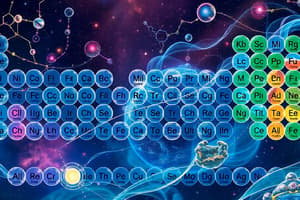Podcast
Questions and Answers
What does inorganic chemistry deal with?
What does inorganic chemistry deal with?
Synthesis and behaviour of inorganic and organometallic compounds.
Which of the following is NOT an application of inorganic chemistry?
Which of the following is NOT an application of inorganic chemistry?
- Quantum Computing (correct)
- Agriculture
- Pigments
- Catalysis
What is the significance of the periodic table?
What is the significance of the periodic table?
It organizes chemical elements and visualizes trends among atoms.
All elements in a group of the periodic table have different numbers of valence electrons.
All elements in a group of the periodic table have different numbers of valence electrons.
Who was awarded the Nobel Prize for his work on the periodic table?
Who was awarded the Nobel Prize for his work on the periodic table?
A horizontal row in the periodic table is called a ______.
A horizontal row in the periodic table is called a ______.
Match the following properties with their description:
Match the following properties with their description:
Flashcards are hidden until you start studying
Study Notes
Inorganic Chemistry Overview
- Inorganic chemistry focuses on the synthesis and behavior of inorganic and organometallic compounds.
- It plays a crucial role in various industries, including catalysis, materials science, pigments, surfactants, coatings, medications, fuels, and agriculture.
Periodic Table
- The periodic table organizes elements by atomic weight, chemical symbols, and atomic numbers.
- It reveals periodic trends in properties among atoms.
- Vertical columns (groups) contain elements with the same number of valence electrons, leading to similar properties.
- Glenn T. Seaborg reconfigured the periodic table in the mid-20th century, placing actinoids below lanthanoids and discovering all trans-uranium elements from 94 to 102.
- Seaborg was awarded the Nobel Prize in Chemistry in 1951; element 106 is named Seaborgium (Sg) in his honor.
- The periodic table highlights that chemical elements are organized by family traits, essential for understanding chemistry's foundational structure.
Trends in Periodic Properties
- Physical properties show distinct trends:
- Atomic Radius: Varies predictably across periods and groups.
- Ionic Radius: Differences between cations and anions.
- Ionization Enthalpy: Energy required to remove an electron.
- Electron Gain Enthalpy: Energy change when an electron is added to an atom.
- Electronegativity: Measure of an atom's ability to attract electrons in a bond.
- Chemical properties reflect:
- Periodicity of Valence or Oxidation States: Trends in how elements lose or gain electrons.
- Anomalous Properties of Second Period Elements: Unique traits influencing chemical behavior.
Chemical Bonding
- Ionic Bond: Formed through the transfer of electrons between atoms.
- Covalent Bond: Involves the sharing of electron pairs between atoms.
- Coordinate Covalent Bond: A type of covalent bond where one atom provides both electrons.
- Metallic Bond: Characterized by a "sea of electrons" that allow conductivity and malleability.
- Hydrogen Bond:
- Intermolecular H-bond: Bonds between molecules affecting boiling and melting points.
- Intramolecular H-bond: Bonds occurring within a molecule influencing its structure.
Mole Concept
- Mole: A unit measuring the amount of substance, defined as containing exactly 6.022 x 10²³ particles.
- Molar Mass: Total mass of one mole of a substance, used for conversions.
- Mass Percentage of Element: Percentage of a specific element's mass in a compound.
Theory of Solution
- Types of Solution: Different methods of combining solute and solvent.
- Concentration of Solution:
- % w/w: Weight percent concentration.
- Mole Fraction (x): Ratio of the number of moles of a component to the total moles in the mixture.
- Molarity (M): Moles of solute per liter of solution.
- Molality (m): Moles of solute per kilogram of solvent.
- Normality (N): Equivalent concentrations of a solution.
Structure of Material (Solids)
- Ionic Solids: Formed from ionic bonds, characterized by high melting and boiling points.
- Metallic Solids: Composed of metal atoms, exhibiting electrical and thermal conductivity.
- Molecular Solids: Composed of molecules held together by intermolecular forces.
- Network Solids: Atoms connected by covalent bonds in a continuous network, resulting in high strength and melting points.
Crystallization of Inorganic Salts
- Involves the process of forming solid crystals from a solution, vital for purifying substances and studying their properties.
Studying That Suits You
Use AI to generate personalized quizzes and flashcards to suit your learning preferences.



